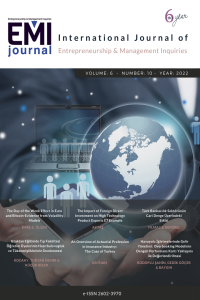Addressing the Asymmetric Causality Between Technological Progress, Economic Globalization, and Income Distribution: The Application of Hatemi-J Approach
Gelir Dağılımı, Emek Payı, Teknolojik İlerleme, Ekonomik Küreselleşme, Hatemi-J Asimetrik Nedensellik Testi
Addressing the Asymmetric Causality Between Technological Progress, Economic Globalization, and Income Distribution: The Application of Hatemi-J Approach
Income Distribution , Labor Share of Income, Technological Progress, Economic Globalization, Hatemi-J Asymmetric Causality Test,
___
- Acemoglu, D. (1998). Why Do New Technologies Complement Skills? Directed Technical Change and Wage Inequality. Quarterly Journal of Economics, 113(4), 1055-1089.
- Acemoglu, D. (2003). Labor- and Capital-Augmenting Technical Change. Journal of the European Economic Association, 1(1), 1-37.
- Aghion, P., Akcigit, U., Bergeaud, A., Blundell, R. and Hemous, D. (2019). Innovation and Top Income Inequality. The Review of Economic Studies, 86(1), 1-45.
- Akerlof, G. A. (1970). The Market for “Lemons”: Quality Uncertainty and the Market Mechanism. Quarterly Journal of Economics, 84(3), 488-500.
- Andersson, M. and Stone, T. A. (2017). Global Sourcing and Technical Efficiency – A Firm Level Study on the ICT Industry in Sweden. Journal of Business Economics and Management, 18(5), 877-896.
- Briguglio, L. and Vella, M. (2016). Technological Advance, the Labour Share of National Income and Income Inequality in the EU. Retrieved from https://core.ac.uk/download/pdf/83022416.pdf
- Dabla-Norris, M. E., Kochhar, M. K. Suphaphiphat, M. N., Ricka, M. F. and Tsounta, E. (2015). Causes and Consequences of Income Inequality: A Global Perspective. IMF Working Papers, SDN/15/13, June.
- Feenstra, R. C., Inklaar, R. and Timmer, M. P. (2015). The Next Generation of the Penn World Table. American Economic Review, 105(10), 3150-3182.
- Granger, C. W. J. and Yoon, G. (2002). Hidden Cointegration. Royal Economic Society Annual Conference 2002 92, Royal Economic Society.
- Gygli, S., Haelg, F., Potrafke, N. and Sturm, J.-E. (2019). The KOF Globalisation Index – Revisited. Review of International Organizations, 14(3), 543-574.
- Hatemi-J., A. (2012). Asymmetric Causality Tests with an Application. Empirical Economics, 43, 447-456.
- Hatemi-J., A., Gupta, R., Kasongo, A., Mboweni, T. and Netshitenzhe, N. (2014). Are there Asymmetric Causal Relationships between Tourism and Economic Growth in a Panel of G-7 Countries? Working Papers, 201476, University of Pretoria, Department of Economics.
- Im, K. S., Pesaran, M. H. and Shin, Y. (2003). Testing for Unit Roots in Heterogeneous Panels. Journal of Econometrics, 115(1), 53-74.
- Maddala, G. S. and Wu, S. (1999). A Comparative Study of Unit Root Tests with Panel Data and a New Simple Test. Oxford Bulletin of Economics and Statistics, 61(S1), 631-652.
- Mnif, S. (2016). Bilateral Relationship Between Technological Changes and Income Inequality in Developing Countries. Atlantic Review of Economics, Colexio de Economistas de A Coruña, Spain and Fundación Una Galicia Moderna, 1, 1-11.
- Neto, A. S. M. and Ribeiro, R. S. M. (2019). A Neo-Kaleckian Model of Skill-Biased Technological Change and Income Distribution. Review of Keynesian Economics, 7(3), 292-307.
- Ostry, J. D., Berg, A. and Tsangarides, C. G. (2014). Redistribution, Inequality, and Growth. IMF Working Papers, SDN/14/02, February.
- Pernica, M. (2017). The Business Impact Analysis of the Minimum Wage Valorisation. Business: Theory and Practice, 18, 88-95.
- Pesaran, M. H. (2004). General Diagnostic Tests for Cross Section Dependence in Panels. IZA Discussion Paper, No. 1240, August.
- Pesaran, M. H. (2006). Estimation and Inference in Large Heterogeneous Panels with a Multifactor Error Structure. Econometrica, 74(4), 967-1012.
- Pesaran, M. H. (2007). A Simple Panel Unit Root Test in the Presence of Cross-Section Dependence. Journal of Applied Econometrics, 22(2), 265-312.
- Pesaran, M. H. and Yamagata, T. (2008). Testing Slope Homogeneity in Large Panels. Journal of Econometrics, 142, 50-93.
- Rajan, R. G. (2015). Democracy, Inclusion, and Prosperity. Speech at the D. D. Kosambi Ideas Festival Goa, India, February 20.
- Sanusi, K. A., Meyer, D. and Ślusarczyk, B. (2017). The Relationship Between Changes in Inflation and Financial Development. Polish Journal of Management Studies, 16(2), 253-265.
- Simionescu, M., Lazányi, K., Sopková, G., Dobeš, K. and Adam, P. B. (2017). Determinants of Economic Growth in V4 Countries and Romania. Journal of Competitiveness, 8(1), 103-116.
- Singh, A. and Dhumale, R. (2000). Globalization, Technology, and Income Inequality: A Critical Analysis. UNU World Institute for Development Economics Research, Working Papers No. 210, December.
- Solt, F. (2020). Measuring Income Inequality Across Countries and Over Time: The Standardized World Income Inequality Database. Social Science Quarterly, 101(3), 1183-1199.
- Spence, A. M. (1973). Job Market Signaling. Quarterly Journal of Economics, 87(3), 355-374.
- Stiglitz, J. (1974). Growth with Exhaustible Natural Resources: Efficient and Optimal Growth Paths. The Review of Economic Studies, 41, 123-137.
- Vveinhardt, J. and Kuklytė, J. (2016). Development Improvement Programme of Social Business Models in Lithuania. Forum Scientiae Oeconomia, 4(4), 149-170.
- Zarotiadis, G. and Gkagka, A. (2013). European Union: A Diverging Union? Journal of Post Keynesian Economics, 35(4), 537-568.
- Zhang, X., Wan, G., Wang, C. and Luo, Z. (2017). Technical Change and Income Inequality in China. World Economy, 2017;00:1-25.
- Zygmunt, A. (2017). Innovation Activities of Polish Firms. Multivariate Analysis of the Moderate Innovator Countries. Oeconomia Copernicana, 8(4), 505-521.
- Yayın Aralığı: Yılda 2 Sayı
- Başlangıç: 2017
- Yayıncı: Himmet KARADAL
Bölgesel Fiyat Farklılıkları ve Konut Fiyat Yakınsaması
Meral ERDİRENCELEBİ, Ebru ERTÜRK
Development of a Turkish Occupational Health and Safety Perceived Competency Scale
Üniversite Öğrencilerinin Girişimcilik Üzerine Görüşleri
The Effect of Covid-19 Pandemic on Intrapreneurship As an Environmental Factor
